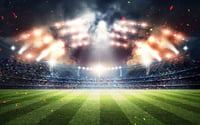What is Arena Soccer?
What is Arena Soccer?
Arena Soccer is played on artificial turf inside a rink wall that’s constructed of dasher boards and plexiglass barriers (think ice hockey). The boards & glass are considered “in play” and the ball may be played off the wall to keep the game moving fast. The shape of the playing field is a rounded rectangle, with typical dimensions being 85 feet wide by 200 feet long. The goals are 8 feet high by 14 feet wide and placed at opposite ends of the rink.
Professional indoor soccer has seen seven different leagues since its’ start in 1978. During the 1980s and 90s, the game enjoyed above average success with the Major Indoor Soccer League (MISL) and the National Professional Soccer League (NPSL). Several teams in this era routinely drew over 10,000 fans per game, topping the local NBA and NHL teams. The MISL also had TV contracts with ESPN and CBS, and some teams had higher TV ratings than the NHL club in the same market. 스포츠토토
BASIC RULES
The artificial turf Field is approximately 200 feet long and 85 feet wide. Dasherboards, topped by Plexiglas, surround the playing field. Players' benches and the penalty boxes are behind the dasherboards at midfield.
The goal is 8 feet high and 14 feet wide and is set into the boards at both ends of the field.
The Ball is 27-28 inches in circumference, weighing 14-16 ounces.
The game is played in four 15-minute quarters. There is a three-minute interval between the first and second quarters and between the third and fourth quarters and a 15-minute halftime. The clock stops when a goal is scored, when the ball leaves the playing area or when there is a penalty kick, penalty call, yellow-line violation, official timeout or any whistle by the referee. The clock restarts with the playing of the ball.
The visiting team has possession for kickoffs in the first and third quarters; the home team in the second and fourth. Play restarts (after the ball leaves the playing area) with a kick-in or a corner kick or distribution from the goalkeeper.
Corner kicks are taken if the ball leaves the playing area between the two flags on the goal line, having been last touched by the defending team. The goalkeeper will distribute the ball if the ball leaves the playing area between the two flags on the goal line, having been last touched by the attacking team. Kickins are taken when the ball leaves the field of play at any other area and will be put back in play by the opposing team at the point the ball left the field longitudinally between flags or top of arc if directly out in the defensive zone.
Each team is allotted three timeouts per game with no more than two to be used per half. A timeout is 60 seconds in length. Timeouts do not accumulate over the course of the game. Teams either use them or lose them. Official timeouts will be called following a stoppage after 8 minutes in each quarter.
Yellow Line violations are called when a forward pass crosses both yellow lines in the air without being touched by another player (except for a throw from the goalkeeper). A violation of this rule results in a change of possession and a direct kick from the offensive yellow line.
THE PLAYERS AND OFFICIALS
A goalkeeper and five field players comprise a team on the field.
Free substitution - all players, including goalkeepers, may change while the flow of the game continues. Any number of substitutions may be made during a game.
Two Referees are on the field and have total jurisdiction over the game. An Assistant Referee is stationed at the timer's bench to supervise the game clock, penalty box, team benches, keep a record of the game and to assist the referees in the control of the game.
GOALS
Goals are scored when the entire ball crosses the goal line.
INFRACTIONS AND RESULTING PENALTIES
Fouls are penalized with a free kick to the offended team, and in some cases, depending upon the severity of the foul, time in the penalty box. A goal can be scored directly from all free kicks.
Penalties are called and time served in the penalty box for Penal offenses, Misconduct and Major violations. All power play time penalties are two 2 minutes in length. Misconducts the referee will show a yellow card) are five 5 minutes in length. The penalty call will not be made delayed time penalty and play stopped until the guilty team gains ball possession or play is otherwise over.
A penalty kick is awarded to a team when a Penal Time Penalty is committed by the opponent in its own penalty area 25 x 30 feet. The penalty kick is taken from the penalty spot 24 feet directly in front of the goal. All players except the designated kicker and goalkeeper must stay behind the yellow line.
Man Advantages power play - a team will play one or two men short when a power play time penalty is called by one of the game officials.
A shootout is awarded for all time penalty infractions which deny a goal-scoring opportunity. The offended team shall designate a player to attempt to score a goal in a one-on-one situation with the opposing goalkeeper. The shootout begins at the center of the defensive yellow line.
All Misconduct Time Penalties are five 5 minutes in length. The guilty player must serve this penalty.
Ejections occur when a player or non-player is guilty of any of the following: violent conduct or serious foul play; foul and/or abusive language or action; an accumulation of any three time penalties.
